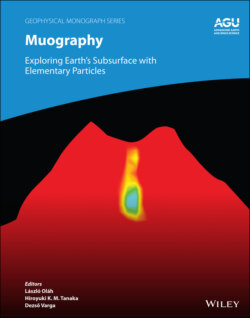Читать книгу Muography - Группа авторов - Страница 60
4.1 INTRODUCTION 4.1.1 The Concept of Machine Learning
ОглавлениеMachine learning (ML) is a process of automated construction of mathematical models based on training data, in order to accomplish decisions or predictions on test data without being explicitly programmed (Samuel, 1959; Géron, 2019). ML aims to perform the cognitive functions of the human brain for tasks that require a lot of fine‐tuning, or are too complex for conventional techniques and human sense organs, to explore hidden information. The first mathematical model of neurons was developed based on the “all‐or‐none” characteristics of nervous activity (McCulloch & Pitts, 1943). Some years later, the perceptron model was developed for storing and organizing information (Rosenblatt, 1958). Currently, support vector machines (SVM) (Vapnik, 1995) and deep neural networks (LeCun et al., 2015) are the most commonly used ML models.
Conceptually, each ML model aims to find a function f that transforms from the space of x inputs (features) to the space of y outputs (labels) for optimization of L(f(x, y)) loss function (Guest et al., 2018). Learning is performed by means of calculation of the gradient of loss function of model parameters. For training of deep neural networks, the application of back‐propagation learning process creates a multi‐level representation approach that automatically discovers the patterns and transforms them to a more abstract representation at each level starting from raw data (Rumelhart et al., 1986). Concerning the necessity of human supervision, three main approaches of ML are distinguished: supervised learning, unsupervised learning, and reinforcement learning. This chapter focuses only on supervised ML. This approach creates the model based on examples that contain both features and labels, and the responses to the test data inputs are given based on the learned feedbacks.
In practice, insufficient quality or quantity of training data or wrong algorithm can result in a suboptimal model. The training data are underfitted when the model is too simple to learn the underlying structure of data. The training data are overfitted when the model overgeneralizes those. The regularization of model can be achieved by means of tuning the parameters of learning algorithm, called hyperparameters. The following developments helped the regularization procedure and accelerated the running of complex ML models: (i) Pre‐training of a hidden layer using the unsupervised learning procedure for restricted Boltzmann machine reduces the dimensionality of complex data (G. E. Hinton & Salakhutdinov, 2006). (ii) Rectified Linear Units (ReLU) activation functions of hidden layers drastically speed up the training of deep neural networks (Nair & Hinton, 2010). (iii.) The dropout technique prevents the overtraining of deep neural networks (Srivastava et al., 2014).
The latest improvements in ML techniques and the rise of graphics processing units revolutionized image and sound recognition (G. Hinton et al., 2012; Krizhevsky et al., 2012), medical imaging and radiation therapy (Esteva et al., 2017; Litjens et al., 2017; Sahiner et al., 2019), computational chemistry (Goh et al., 2017), biology and medicine (Ching et al., 2018), astrophysics (VanderPlas et al., 2012), high energy physics (A Living Review of Machine Learning for Particle Physics, 2020; Guest et al., 2018; Radovic et al., 2018), etc. The improvement of geophysical signal processing techniques is required for automated exploration and classification of various signals from Earth’s subsurface and forecasting of the geophysical phenomena including those triggering various natural hazards, such as volcano eruptions (Reath et al., 2016; Sparks, 2003), earthquakes (Geller, 1997), landslides (Korup & Stolle, 2014), or tsunamis (Titov et al., 2005). Although statistical algorithms have already achieved progress in the prediction of short‐term volcano eruptions (Brancato et al., 2016; Newhall & Hoblitt, 2002), it was natural to also consider using ML techniques. In the following sections, we focus on the prediction of volcano eruptions with ML techniques.
